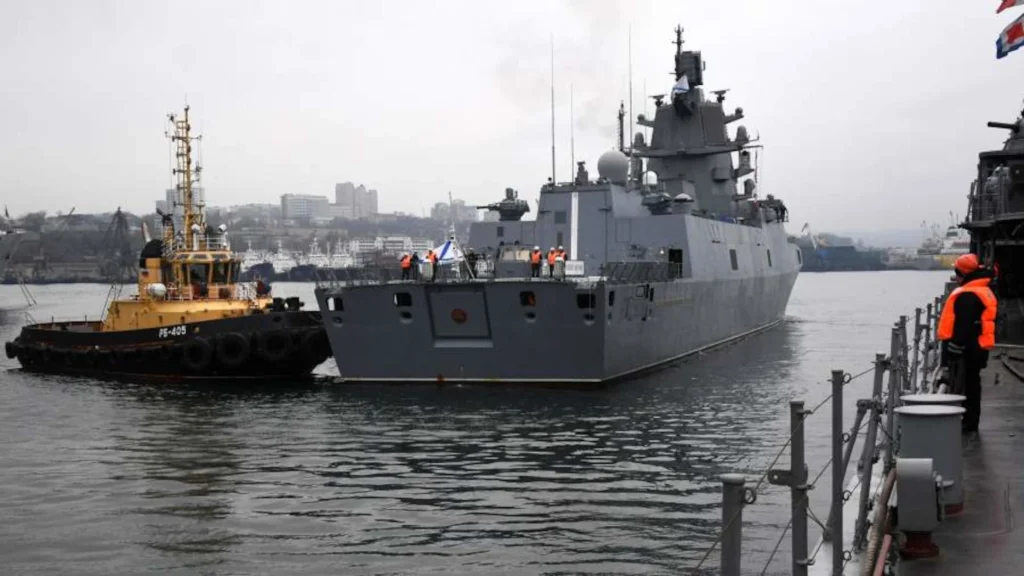The second serial nuclear submarine missile carrier of project 955A (code “Borey-A”) “Generalissimo Suvorov” will become part of the Russian Navy in December 2022, said United Shipbuilding Corporation (USC) representative on Monday, March 21. The same month will see the induction of Project 22350 frigate Admiral Golovko in the Northern Fleet. It will become the first full-time carrier of the Zircon hypersonic system.
Generalissimo Suvorov
Suvorov will begin carrying out complex mooring and factory sea trials at sea, and then the cruiser will undergo a complete cycle of state tests in the fall.
Submarines of the 4th generation are being constructed within the framework of the 995A project. “Borey-A” has been significantly upgraded in noise reduction, improved manoeuvrability, and increased degree of automation. These submarines do not contain any imported materials and mechanisms. Externally, the hull of project 955A differs from 955 due to the absence of a hump. There are no analogues of such submarines in foreign fleets yet.
The Generalissimo Suvorov and other 995A ships will replace Project 667BDRM and 667BDR boats, which will retire in 2030.
The lead ship of the Borei-A project, Prince Vladimir, was built at JSC PO Sevmash and transferred to the Navy on June 12, 2020. The first production missile carrier, Prince Oleg, was transferred to the Navy on December 21, 2021.
R-30 Bulava ICBM
The submarines are equipped with intercontinental ballistic missiles R-30 Bulava. R-30 Bulava is a three-stage solid-propellant missile carrying six individually targetable warheads. As per media reports, the flight range of the missile is 10 thousand km, the payload is 1.1 tons, and the probable Circular Error Probability (CEP) is from 120 to 350 m.
Bulava can be launched from under the Arctic ice. For comparison, Project 667 cruisers equipped with R-29RMU2 Sineva and R-29RMU2.1 Liner (Layner) liquid-propellant missiles can fire only after breaking through the ice.
Bulava’s boost phase lasts about five minutes, which makes it difficult to use the missile defense system. The missiles manoeuvre during the flight, which makes it possible to bypass missile defense systems in the second stage. At the third stage, when nuclear blocks enter the atmosphere, they go at hypersonic speeds, which missile defense systems, in principle, do not see.
Bulava was adopted in the Navy after the R-39UTTH Bark project failed. The Bulava project was initially called Boreev.
Admiral Golovko
The frigate’s crew is currently completing their training, and in autumn, sailors will begin the test of the frigate at sea. The tests are scheduled to be completed in December.
As per Russian media, Severomorsk will be the home of Admiral Golovko. Currently, the construction of a berth and infrastructure for the frigate is being completed in Severomorsk. It is assumed that the ship will be part of the 43rd division of missile ships of the Northern Fleet (SF). The Northern Fleet includes the largest and most powerful combat units, in particular, the aircraft-carrying cruiser Admiral Kuznetsov and the flagship of the Northern Fleet, the nuclear-powered missile cruiser Peter the Great.

Last spring, the Commander-in-Chief of the Navy Admiral Nikolai Evmenov said that Project 22350 frigates would become the first carriers of hypersonic weapons. Admiral Gorshkov, the lead ship of this series, tested the new Zircon system, including the first practical launches.
Admiral Golovko will be the third ship of project 22350. The series was laid down in 2006. The lead ship Admiral Gorshkov was handed over to the fleet in 2018. The second ship Admiral Kasatonov went into operation in July last year.
The Russian Navy has planned eight frigates of the ‘Admiral’s series, as they are called in the Navy. Admiral Isakov is now at the final stage, and work is underway on the construction of Admiral Chichagov. In 2020, Admiral Spiridonov and Admiral Yumashev were laid down, and two more ships are planned to be laid down this year.
